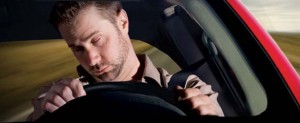Have you ever caught yourself nodding off behind the wheel? You wouldn’t be alone. As many as a third of all drivers admit they’ve done so at some time or another, and drowsy driving catches the blame for at least 100,000 crashes and more than 1,500 deaths annually in the United States.
A new study by the Centers for Disease Control, meanwhile, finds that one of every 24 U.S. adults admit they’ve fallen asleep while driving at least once during the previous month – and experts believe that number is low because motorists often don’t realize when they’ve had a second or two “micro-sleep.”
Even a moment dozing off can be disastrous, however, considering that at just 60 miles per hour a vehicle will travel about 88 feet, or about four to five car lengths.
“If I’m on the road, I’d be a little worried about the other drivers” after reading the results of the study, said lead author Anne Wheaton, of the CDC.
The telephone survey reached out to 147,000 adults in 19 states and the District of Columbia making it the largest poll of its kind. It revealed that 4% of respondents admitted nodding off during the previous month at least once.
Earlier studies, such as one conducted by the National Sleep Foundation in 2005, have been even more worrisome. The NSF reported 60% of adult drivers drove a vehicle while drowsy at least once during the prior year while 37% said they actually nodded off. And of those who acknowledged falling asleep, 13% said they routinely did that at least once a month.
The Sleep Foundation study also revealed 4% of its survey pool admitted either having an accident or a near accident because they were drowsy or fell asleep behind the wheel.
That finding from the earlier, smaller study is in line with government estimates that suggest at least 3% of fatal highway crashes involve drowsy drivers or those who fell asleep. Some other analysts put the number as high as 33%, however.
According to the National Highway Traffic Safety Administration’s more conservative estimate, there are still 100,000 crashes a year caused by sleepy motorists – resulting in an estimated 40,000 injuries and 1,550 deaths annually.
The latest CDC research found that men are more likely to nod off behind the wheel, as are drivers between the ages of 25 and 34 and those who routinely get less than six hours of sleep a night. An earlier Gallup survey found males are twice as likely as women to drive drowsy.
Part of the challenge for researchers is to get accurate results as everyone defines drowsy driving differently and motorists may often be unaware that they’ve actually nodded off for a second or two.
A study by the Virginia Tech Transportation Institute used cameras and other sensors in 100 vehicles to see what happens on the road. Though the numbers were small, the year-long study allowed researchers to project that drowsiness contributed, to some degree, to 20% of all crashes. They estimated a drowsy motorist is four to six times more likely to be involved in a collision than one who is wide awake.
Unlike drunk drivers, it can be difficult for police to detect a drowsy driver. But new technology is aimed at alerting motorists themselves. A number of vehicles, including products from Lexus and Mercedes-Benz, are programmed to spot signs that a driver is getting sleepy. Some look for specific steering wheel inputs, another system aims a camera at the driver’s face.
Most of the technologies simply try to flag a driver if that happens, perhaps by flashing a coffee cup emblem somewhere on the instrument panel or sounding a chime.
Ford has added a drowsy driving alert that it has paired with the optional new Lane-Keeping Assist system on the 2013 Fusion sedan. It uses a forward-facing camera to watch for visible road markings, alerting the driver by vibrating the steering wheel if the system senses the car drifting out of its lane.
“We found the drivers we talked to were definitely inclined toward features that provided real practical benefits by alerting them to potentially hazardous situations they may have missed,” according to Billy Mann, managing director of Penn Schoen Berland, which conducted a recent survey for Ford looking at how consumers reacted to new safety technology.


This and many other realities make driving a serious hazard these days.